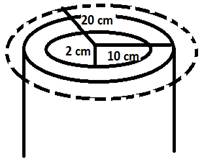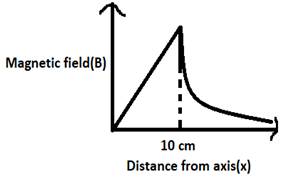A solid wire of radius 10 cm carries a current of 5.0 A distributed uniformly over its cross section. Find the magnetic field B at a point at a distance.
(a) 2 cm
(b) 10 cm and
(c) 20 cm away from the axis. Sketch a graph of B versus x for 0 < x < 20 cm.
Given:
Radius of wire(r) = 10 cm = 0.1 m
Current carried by it(i) = 5 A
Diagram:

Formula used:
Ampere’s circuital law states that the line integral of the magnetic field for a closed surface is μ0 times the current enclosed by the surface.
![]() ,
,
Where B = magnetic field, dl = line element, μ0 = magnetic permeability of vacuum, I = current enclosed.
(a) Since the current is uniformly distributed over the cross section of the wire, at a distance of 2 cm (0.02 m) from the axis (inside the wire), I (current enclosed)
= ![]()
Where,
A = 0.2 A, where 0.1 m is the radius of the wire.
Hence, from Ampere’s circuital law,
![]()
where μ0 = magnetic permeability of vacuum = 4π x 10-7 T m A-1, B = magnetic field, dl = line element, I = current enclosed
Substituting the values, we get
B x 2π x 0.02 = 4π x 10-7 x 0.2 (since 2π x 0.02 = circumference of the loop of radius 2 cm)
=> Magnetic field at a distance of 2 cm from the axis
= 2 x 10-6 T = 2μT (Ans)
(b) At a distance of 10 cm from the axis, we are basically on the surface of the wire. Hence the whole current of 5 A is enclosed by it.
Hence, from Ampere’s circuital ,![]() ,
,
where μ0 = magnetic permeability of vacuum = 4π x 10-7 T m A-1, B = magnetic field, dl = line element, I = current enclosed
Here, I = 5 A.
Substituting the values, we get
B X 2π x 0.1 = 4π x 10-7 x 5(since 2π x 0.1 is the circumference of the loop of radius 10 cm)
=> Magnetic field at a distance of 10 cm from the axis
= 10-5 T = 10μT (Ans)
(c) At a distance of 20 cm from the axis, we are outside the wire. Hence the whole current of 5 A is enclosed by it.
Hence, from Ampere’s circuital law, ![]() ,
,
where μ0 = magnetic permeability of vacuum = 4π x 10-7 T m A-1, B = magnetic field, dl = line element, I = current enclosed
Here, I = 5 A.
Substituting the values, we get
B X 2π x 0.2 = 4π x 10-7 x 5(since 2π x 0.2 is the circumference of the loop of radius 20 cm)
=> Magnetic field at a distance of 20 cm from the axis
= 5 x 10-6 T = 5μT (Ans)
Graph for B vs x for 0 < x < 20 cm:
